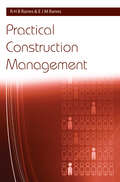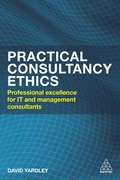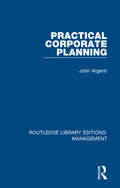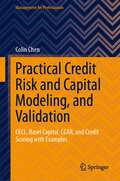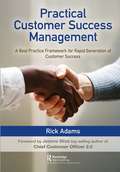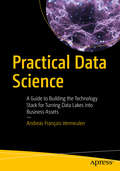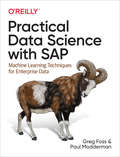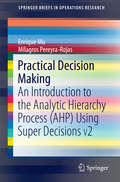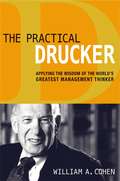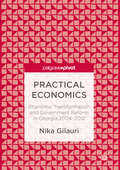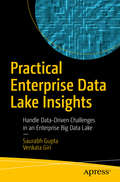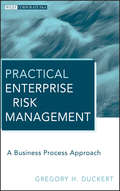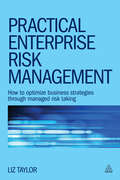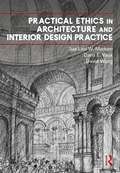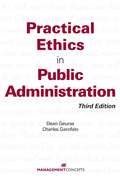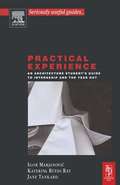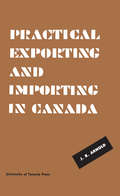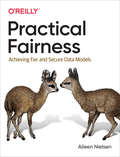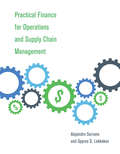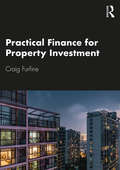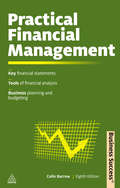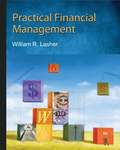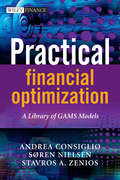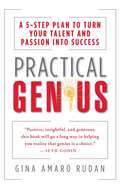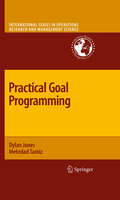- Table View
- List View
Practical Construction Management
by R. H. Ranns E. J. RannsFilled with practical advice for all aspects of the construction manager's role, this invaluable book fills a need for training in this essential subject, to ensure greater efficiency on site and smoother client-contractor relations. Developed as a handy-reference guide for practitioners and also useful for students, it covers the broad range of responsibilities associated with the role, providing clear guidance and in-depth coverage of the essentials. Topics include financial responsibilities and how to handle them, tender preparation, people management, health and safety, contracts, subcontracting, measurement and quantities, insurance and risk and many more simple and effective methods for turning construction projects into reality.
Practical Consultancy Ethics: Professional Excellence for IT and Management Consultants
by David YardleyConsultants - working for an organization but not as part of it - are particularly subject to commercial pressures from both their employers and their clients, never more so than when consulting on complex and costly IT engagements. A consultant's reputation is crucial to their professional capital, and they have to be able to make defensible decisions that protect this reputation whilst delivering value for the client. This means acting ethically, responsibly and commercially. Practical Consultancy Ethics approaches the subject of ethics from the individual's perspective: the management or IT consultant who will need to make ethical decisions within their engagement. With clear-sighted identification of the ethical dilemmas that may arise at each stage of a consultancy project - from defining the problem to fit the solution, through to prioritizing competing stakeholder needs, and having access to confidential client information - and guidance on ethical and risk-reducing actions that consultants can take, the emphasis throughout is on improved decision-making. Enhanced with case studies showcasing real-life ethical pitfalls and featuring consultancy ethical dilemmas to challenge the reader, this is a uniquely practical guide to applying best ethical practice in consulting engagements.
Practical Corporate Planning: A Practical Guide (Routledge Library Editions: Management #4)
by John ArgentiIn this book, originally published in 1980, John Argenti deliberately and systematically strips away the sophisticated methods for corporate planning to get down to a practical corporate planning process that works. This accessible book uses no jargon or maths, and will be of interest to students of management and business studies. It is also aimed at chief executives, managing directors and other very senior executives in companies and non-profit-making organisations.
Practical Credit Risk and Capital Modeling, and Validation: CECL, Basel Capital, CCAR, and Credit Scoring with Examples (Management for Professionals)
by Colin ChenThis book provides professionals and practitioners with a comprehensive guide on credit risk modeling, capital modeling, and validation for Current Expected Credit Loss (CECL), International Financial Reporting Standard 9 (IFRS9), Basel Capital and Comprehensive Capital Analysis and Review (CCAR) procedures. It describes how credit risk modeling, capital modeling, and validation are done in big banks with code and examples. The book features innovative concepts such as Binary Logit Approximation (BLA) for Competing Risk Framework; Adaptive and Exhaustive Variable Selection (AEVS) for automatic modeling; Full Observation Stratified Sampling (FOSS) for unbiased sampling; and Prohibited Correlation Index (PCI) for Fair Lending Texts. It also features a chapter on credit underwriting and scoring, addressing the credit underwriting risk with some innovations. It is a valuable guide for professionals, practitioners and graduate students in risk management.
Practical Customer Success Management: A Best Practice Framework for Rapid Generation of Customer Success
by Rick Adams"This book contains so much common sense that my neck was getting tired from nodding my head in agreement so often." Peter Armaly, Senior Director Customer Success, Oracle "…a comprehensive review of the Customer Success role and responsibilities…" Anne Marie Ponder, Senior Manager, IT Infrastructure, Astellas Pharma US "…a must read playbook for all business leaders and customer success-focused professionals." Jason Noble, Global Customer Success and SaaS Leader "I wish a book like this existed when I started in Customer Success!" Cyn Taylor, Enterprise Customer Success Manager, LogicMonitor "…provides all the ingredients to create the right customer success strategy." Baptiste Debever, Head of Growth & Co Founder, Alkalab "…an invaluable resource for anyone with an interest in Customer Success." Adam Joseph, CEO, CSM insight "A structured and logical approach that will help new and experienced CSMs to bridge the gap between Customer Success theory and practical application." James Scott, General Partner, Success Hacker Customer success management is "the practice of helping customers to generate value from using our products" and it is a relatively new and fast-growing profession with many new CSMs coming into it from other customer-facing professions. Due to the speed with which the profession is undergoing change as it matures and expands, both new and existing CSMs need to keep abreast of customer success best practice. However there are relatively few books that provide much in the way of practical guidance for customer success practitioners and even less options for resources such as tools, templates and checklists that enable a consistently high quality approach whilst increasing the CSM’s productivity. Practical Customer Success Management is a practical guide book and comprehensive training manual for CSMs that provides a simple to follow, best practice framework that lays out the core steps at every stage of the customer journey to business outcome success. It describes and explains which situations each step applies to and provides recommendations for activities or tasks that the CSM can perform to complete each step, together with detailed guidance for successfully completing those activities. The book also includes a suite of tools and templates that enable rapid completion of tasks whilst ensuring consistency of approach both across multiple customer engagements and by multiple CSMs within a team.
Practical Data Science
by Andreas François VermeulenLearn how to build a data science technology stack and perform good data science with repeatable methods. You will learn how to turn data lakes into business assets.The data science technology stack demonstrated in Practical Data Science is built from components in general use in the industry. Data scientist Andreas Vermeulen demonstrates in detail how to build and provision a technology stack to yield repeatable results. He shows you how to apply practical methods to extract actionable business knowledge from data lakes consisting of data from a polyglot of data types and dimensions.What You'll LearnBecome fluent in the essential concepts and terminology of data science and data engineering Build and use a technology stack that meets industry criteriaMaster the methods for retrieving actionable business knowledgeCoordinate the handling of polyglot data types in a data lake for repeatable resultsWho This Book Is ForData scientists and data engineers who are required to convert data from a data lake into actionable knowledge for their business, and students who aspire to be data scientists and data engineers
Practical Data Science with SAP: Machine Learning Techniques for Enterprise Data
by Greg Foss Paul ModdermanLearn how to fuse today's data science tools and techniques with your SAP enterprise resource planning (ERP) system. With this practical guide, SAP veterans Greg Foss and Paul Modderman demonstrate how to use several data analysis tools to solve interesting problems with your SAP data.Data engineers and scientists will explore ways to add SAP data to their analysis processes, while SAP business analysts will learn practical methods for answering questions about the business. By focusing on grounded explanations of both SAP processes and data science tools, this book gives data scientists and business analysts powerful methods for discovering deep data truths.You'll explore:Examples of how data analysis can help you solve several SAP challengesNatural language processing for unlocking the secrets in textData science techniques for data clustering and segmentationMethods for detecting anomalies in your SAP dataData visualization techniques for making your data come to life
Practical Decision Making
by Enrique Mu Milagros Pereyra-RojasThis book offers a simple introduction to the fundamentals and applications of the Analytic Hierarchy Process (AHP) without a pre-requisite for a sophisticated mathematical background. It provides a quick and intuitive understanding of the methodology using spreadsheet examples and explains in a step-by-step fashion how to use Super Decisions, a freely available software developed by the Creative Decisions Foundations. The book is intended to be a resource for decision makers with little or no exposure to the field of Operations Research (OR); however, the book can be used as a very gentle introduction to the AHP methodology and/or as an AHP hands-on supplement for standard OR textbooks. AHP is an intuitive and mathematically simple methodology in the field of multi-criteria decision making. Because of this, most AHP books assume the reader has basic OR mathematical background. However, AHP simplicity suggests that decision makers from all disciplines can take advantage of the methodology without struggling with the mathematics behind it. To fulfill this need, this book delivers a quick and practical understanding of the method that can be useful for corporate executives.
The Practical Drucker: Applying the Wisdom of the World's Greatest Management Thinker
by William A. CohenFew thinkers have had a greater impact on business than Peter Drucker, the inventor of modern management, whose legacy continues to influence leaders around the globe. His keen observations about organizations took the form of deceptively simple truths and astute predictions. Concepts such as decentralization, outsourcing, the rise of the knowledge worker, the role of employees as assets, and a focus on the customer--it was Drucker who first expressed them, sometimes decades before they be came accepted wisdom. Although renowned as a thinker and idea generator, the "what" in his teachings was far more prevalent than the "how." Now, The Practical Drucker mines his vast body of work to pinpoint 40 applicable truths for solving real-world problems. Readers will find surprising insights and clear guidance on how to: * Engage employees and achieve outstanding performance * Remedy destructive office politics * Approach innovation * Ensure follow-through on good ideas by establishing controls * Handle a crisis * Become better decision makers by questioning assumptions * Determine which leadership style to use in which situation * Do more with less * Steer clear of the biggest traps that leaders fall into * Avoid the five deadly marketing sins * And much more In succinct, satisfying chapters, the book distills the practical wisdom from Drucker's myriad books, essays, articles and his decades of teaching and consulting into a set of fresh, vital lessons that will resonate today and for years to come.
Practical Economics
by Nika GilauriThis book is open access under a CC BY license. In this book, Nika Gilauri reveals his formulas for government reform and economic recovery, including how to fight against corruption, reform fiscal policy and tax systems, privatize state-owned enterprises, build a welfare system for those most in need, create a competitive education and healthcare system, and streamline procurement. All formulas are corroborated by practical experience and empirical evidence gathered during Mr Gilauri's term as a cabinet member (2004-2009) and prime minister (2009-2012) of Georgia, and provide an in-depth view of what worked in the case of Georgia since 2003, and how lessons learned could be applied in other parts of the world.
Practical Enterprise Data Lake Insights: Handle Data-Driven Challenges in an Enterprise Big Data Lake
by Saurabh Gupta Venkata GiriUse this practical guide to successfully handle the challenges encountered when designing an enterprise data lake and learn industry best practices to resolve issues.When designing an enterprise data lake you often hit a roadblock when you must leave the comfort of the relational world and learn the nuances of handling non-relational data. Starting from sourcing data into the Hadoop ecosystem, you will go through stages that can bring up tough questions such as data processing, data querying, and security. Concepts such as change data capture and data streaming are covered. The book takes an end-to-end solution approach in a data lake environment that includes data security, high availability, data processing, data streaming, and more.Each chapter includes application of a concept, code snippets, and use case demonstrations to provide you with a practical approach. You will learn the concept, scope, application, and starting point.What You'll LearnGet to know data lake architecture and design principlesImplement data capture and streaming strategiesImplement data processing strategies in HadoopUnderstand the data lake security framework and availability modelWho This Book Is ForBig data architects and solution architects
Practical Enterprise Risk Management
by Gregory H. DuckertThe most practical and sensible way to implement ERM-while avoiding all of the classic mistakesEmphasizing an enterprise risk management approach that utilizes actual business data to estimate the probability and impact of key risks in an organization, Practical Enterprise Risk Management: A Business Process Approach boils this topic down to make it accessible to both line managers and high level executives alike. The key lessons involve basing risk estimates and prevention techniques on known quantities rather than subjective estimates, which many popular ERM methodologies consist of.Shows readers how to look at real results and actual business processes to get to the root cause of key risksExplains how to manage risks based on an understanding of the problem rather than best guess estimatesEmphasizes a focus on potential outcomes from existing processes, as well as a look at actual outcomes over timeThroughout, practical examples are included from various healthcare, manufacturing, and retail industries that demonstrate key concepts, implementation guidance to get started, as well as tables of risk indicators and metrics, physical structure diagrams, and graphs.
Practical Enterprise Risk Management
by Liz TaylorPractical Enterprise Risk Management addresses the real need for organizations to take more managed risks in order to maximise business strategies and achieve long term goals. Based on ISO 31000 and applying current best practice, it provides templates and examples that can be adapted for any industry. Breaking down the theory on enterprise risk management, it helps you see risk as both an opportunity and a threat whilst giving you guidance on how to implement it. It provides models for Risk Adjusted Return on Capital to evaluate R.O.I and measure performance, advice on emergent risks, as well as best practice and advice on risk communication, transparency and protecting the brand.Including a comprehensive overview of risk management responsibilities for boards, Practical Enterprise Risk Management lifts the lid on the whole process, helping you to embed ERM into your organization, reach your goals and take more managed risks.
Practical Ethics in Architecture and Interior Design Practice
by Sue Lani Madsen Dana E. Vaux David WangPractical Ethics in Architecture and Interior Design Practice presents the basics of design practice through ethical scenarios, ushering design students into real-world experiential learning. Each chapter begins with a detailed story involving a complicated set of practical and ethical dilemmas, exemplifying those encountered each day in the world of professional practice. Practice-based topics such as contracts and project delivery methods, marketing design services, cross-cultural collaboration, virtual connectivity, social justice and sustainable design, soft skills, and other related professional practice themes are anchored in realistic scenarios. While all the stories are fictional, in writing them the authors drew from over seventy-five combined years of professional experience in architecture and interior design as well as many years of academic experience in teaching professional practice and ethics to architecture and interior design students. Each story is followed by discussion questions and suggested additional resources. This book provides a unique integrated perspective into the allied fields of architecture and interior design with topics relevant to both fields as well as specific to each profession. It prepares students of both disciplines for the broad issues of professional practice and encourages them to become ethical practitioners ready to contribute effectively to design teams and to ask the right questions.
Practical Ethics In Public Administration
by Dean Gueras Charles GarofaloMake the Right Choice - Enhance Your Ethical Decision Making Skills Today!Ethical issues arise in all walks of life, but none have implications as far-reaching and serious as those related to public management. Most people working in the public sector want to do the "right" thing, but the issues can be highly complex or just not lend themselves to easy answers. Practical Ethics in Public Administration, Third Edition, provides the tools, techniques, and methods needed to help meet these challenges. This completely updated third edition provides public sector professionals the information they need to face the ethical issues that arise in the course of a day's work, address those issues with greater self-assurance, perform their duties in an ethically justifiable manner, and explain their actions reasonably.This new edition:• Covers emerging ethical issues surrounding public-private partnerships• Examines the shift from compliance-based to integrity-based ethics programs• Explores the context of moral competency
Practical Experience: An Architecture Student's Guide To Internship And The Year Out
by Katerina Ruedi Ray Jane TankardThe year out, or internship, in a professional practice can be the most rewarding experience in an architectural student's education. It can also be a shock to the system to find that architectural working practices are very different to architectural study. This book provides a beginner's guide to professional practice and a step-by-step guide on how to find the placement that best suits your goals. It is the fourth title in the successful 'Seriously Useful Guides...' series.In order to give you a real insight into professional experience, this guide includes reallife case studies from students who have been through the experience and from practices that have taken them on. It guides you through the steps of finding a placement, outlines the norms and expectations for internship in different countries, and discusses codes of office behavior and professional ethics. Contemporary architecturalpractices are becoming increasingly diverse and this guide outlines some Practical experience/Internship choices, providing cases studies of award wining firms that offer practical experience. These case studies range from conventional practices based on the art of building, to practices based on digital media or contemporary urbanism. Finally, the term 'critical practice' is becoming increasingly important, and the book provides some definitions and examples of critically based architectural practices.Also in the Seriously Useful Guides Series:* The Crit* The The Portfolio* The Dissertation
Practical Exporting and Importing in Canada
by J. R. ArnoldAs every schoolboy knows, Canada is one of the larger trading countries of the world but, from the point of view of balancing her international merchandise trade payments, she does not export enough. The purpose of this book is to describe, not in broad economic terms, but in daily practical detail, the work of the exporter and importer. Pitfalls abound for the unwary trader, and Mr. Arnold knows them all. His book is written about the activities of an export merchant, since he, unlike his confrères in a larger type of organization, deals directly himself with banks, brokers, suppliers, shippers, buyers, insurance agents, freight forwarders, and the other agencies serving the exporter and importer. Thus the reader acquires an all-round understanding of the trader's business world. The book is written with admirable directness and clarity, with an astute and alert business sense underlying the writing. The book will also make useful reading for any student of international trade theory and would be especially helpful to commerce classes and to trainees in business firms of all kinds associated with Canadian trade.
Practical Fairness: Achieving Fair And Secure Data Models
by Aileen NielsenFairness is an increasingly important topic as machine learning and AI more generally take over the world. While this is an active area of research, many realistic best practices are emerging at all steps along the data pipeline, from data selection and preprocessing to blackbox model audits. This book will guide you through the technical, legal, and ethical aspects of making your code fair and secure while highlighting cutting edge academic research and ongoing legal developments related to fairness and algorithms.There is mounting evidence that the widespread deployment of machine learning and artificial intelligence in business and government is reproducing the same biases we are trying to fight in the real world. For this reason, fairness is an increasingly important consideration for the data scientist. Yet discussions of what fairness means in terms of actual code are few and far between. This code will show you how to code fairly as well as cover basic concerns related to data security and privacy from a fairness perspective.
Practical Finance for Operations and Supply Chain Management
by Alejandro Serrano Spyros D. LekkakosAn introduction to financial tools and concepts from an operations perspective, addressing finance/operations trade-offs and explaining financial accounting, working capital, investment analysis, and more.Students and practitioners in engineering and related areas often lack the basic understanding of financial tools and concepts necessary for a career in operations or supply chain management. This book offers an introduction to finance fundamentals from an operations perspective, enabling operations and supply chain professionals to develop the skills necessary for interacting with finance people at a practical level and for making sound decisions when confronted by tradeoffs between operations and finance. Readers will learn about the essentials of financial statements, valuation tools, and managerial accounting.The book first discusses financial accounting, explaining how to create and interpret balance sheets, income statements, and cash flow statements, and introduces the idea of operating working capital—a key concept developed in subsequent chapters. The book then covers financial forecasting, addressing such topics as sustainable growth and the liquidity/profitability tradeoff; concepts in managerial accounting, including variable versus fixed costs, direct versus indirect costs, and contribution margin; tools for investment analysis, including net present value and internal rate of return; creation of value through operating working capital, inventory management, payables, receivables, and cash; and such strategic and tactical tradeoffs as offshoring versus local and centralizing versus decentralizing. The book can be used in undergraduate and graduate courses and as a reference for professionals. No previous knowledge of finance or accounting is required.
Practical Finance for Property Investment
by Craig FurfinePractical Finance for Property Investment provides readers with an introduction to the most fundamental concepts, principles, analytical methods, and tools useful for making investing and financing decisions regarding income-producing property. The book begins by considering how to value income-producing property by forecasting a property’s cash flows and estimating appropriate discount rates. It then discusses how both debt and private equity are used as methods to finance a property’s acquisition. The book provides a thorough discussion of the taxation of property income as well as how investors can quantify the risks to investing in property. The book concludes with important considerations for investors when their investment thesis does not come to fruition. Practical Finance for Property Investment offers a unique and novel pedagogy by pairing each book chapter with an in-depth real-world case study, which forces readers to confront the occasional tensions between finance theory and property investment practice. The book is designed for investors and students interested in learning what finance theory implies about property investment. Readers and Instructors can access electronic resources, including the spreadsheets used in the textbook, at the book's website: www.routledge.com/9780367333041.
Practical Financial Management
by Colin BarrowEntrepreneurs need to be financially literate. The most common cause of business failure is poor financial control stemming from an ignorance of the basics of business finance. Practical Financial Management is intended to help those who find business finance confusing. Now in its eighth edition, it continues to provide advice on proper financial planning and control, and reinforces essential points through the use of questions within each section. Beginning with an introduction to the key financial statements, it moves on to look at the tools of financial analysis - the keys to controlling a business successfully. The final part of the book deals with business planning and budgeting, a vital area of business finance as most new ventures cannot get off the ground without a business plan, and existing businesses cannot expand. Now with more examples and explanations of key terms, as well as information on loans for small businesses and guidance on how to analyze business accounts, Practical Financial Management is an invaluable read for aspiring entrepreneurs and those already in business. This book could mean the difference between success and failure.
Practical Financial Management
by William R. LasherThe author William R. Lasher captivates readers with unique insights into the issues and challenges facing financial managers every day. rom a look at hidden agendas and the biases of decision makers in the firm to the analyses of financial proposals, Lasher's practical, relevant presentation keep students reading. This edition examines the latest financial developments, including the financial crisis of 2008-2009. You will find an engaging, complete presentation perfectly matched to the needs of today's business students, from the use of everyday math, rather than advanced math in theory sections, to numerous worked-out examples and graphical and intuitive presentations.
Practical Financial Optimization
by Stavros A. Zenios Andrea Consiglio Soren S NielsonIn Practical Financial Optimization: A Library of GAMS Models, the authors provide a diverse set of models for portfolio optimization, based on the General Algebraic Modelling System. 'GAMS' consists of a language which allows a high-level, algebraic representation of mathematical models and a set of solvers - numerical algorithms - to solve them. The system was developed in response to the need for powerful and flexible front-end tools to manage large, real-life models.The work begins with an overview of the structure of the GAMS language, and discusses issues relating to the management of data in GAMS models. The authors provide models for mean-variance portfolio optimization which address the question of trading off the portfolio expected return against its risk. Fixed income portfolio optimization models perform standard calculations and allow the user to bootstrap a yield curve from bond prices. Dedication models allow for standard portfolio dedication with borrowing and re-investment decisions, and are extended to deal with maximisation of horizon return and to incorporate various practical considerations on the portfolio tradeability. Immunization models provide for the factor immunization of portfolios of treasury and corporate bonds.The scenario-based portfolio optimization problem is addressed with mean absolute deviation models, tracking models, regret models, conditional VaR models, expected utility maximization models and put/call efficient frontier models. The authors employ stochastic programming for dynamic portfolio optimization, developing stochastic dedication models as stochastic extensions of the fixed income models discussed in chapter 4. Two-stage and multi-stage stochastic programs extend the scenario models analysed in Chapter 5 to allow dynamic rebalancing of portfolios as time evolves and new information becomes known. Models for structuring index funds and hedging interest rate risk on international portfolios are also provided.The final chapter provides a set of 'case studies': models for large-scale applications of portfolio optimization, which can be used as the basis for the development of business support systems to suit any special requirements, including models for the management of participating insurance policies and personal asset allocation.The title will be a valuable guide for quantitative developers and analysts, portfolio and asset managers, investment strategists and advanced students of finance.
Practical Genius: A 5-Step Plan to Turn Your Talent and Passion into Success
by Gina Amaro RudanWHAT’S YOUR GENIUS?Most people consider genius to be a gift, a “lightning bolt from the gods” that strikes people like Einstein or Mozart, but not the rest of us. They see it as a quality—like creativity—that has a magical, exclusive, elusive connotation. That is simply not true, says Gina Rudan. Every one of us has a capacity for genius. Anyone is capable of achieving something so extraordinary that it could change the game for you, your business, and every aspect of your life. In Practical Genius, Rudan shows you how to: • Identify your genius • Express it in everyday life • Surround yourself with genius • Sustain genius for a lifetime of personal and professional satisfaction • Market your genius to others Each stage features exercises to guide you along the way, leaving you feeling accomplished and ready for the next stage. The outcome is a profound revelation: You have the tools and ability to realize greatness both in and out of the workplace. UNLEASH YOUR GENIUSForget what you think you know about genius. It’s not about having a Mensa I.Q. or painting the Sistine Chapel. Everyone’s got genius, but it’s up to you to find it, put it to work, and watch it change your life. With the help of Practical Genius, you will: Identify your genius. Where do your passions and your talents meet? (page 23) Express your genius. What’s your story, and how do you share it with others? (page 57) Surround yourself with genius. Who do you need in your tribe? (page 93) Sustain your genius. How do you feed and care for your genius? (page 135) Market your genius. Why are your contradictions actually your largest competitive advantage? (page 165)
Practical Goal Programming
by Mehrdad Tamiz Dylan JonesPractical Goal Programming is intended to allow academics and practitioners to be able to build effective goal programming models, to detail the current state of the art, and to lay the foundation for its future development and continued application to new and varied fields. Suitable as both a text and reference, its nine chapters first provide a brief history, fundamental definitions, and underlying philosophies, and then detail the goal programming variants and define them algebraically. Chapter 3 details the step-by-step formulation of the basic goal programming model, and Chapter 4 explores more advanced modeling issues and highlights some recently proposed extensions. Chapter 5 then details the solution methodologies of goal programming, concentrating on computerized solution by the Excel Solver and LINGO packages for each of the three main variants, and includes a discussion of the viability of the use of specialized goal programming packages. Chapter 6 discusses the linkages between Pareto Efficiency and goal programming. Chapters 3 to 6 are supported by a set of ten exercises, and an Excel spreadsheet giving the basic solution of each example is available at an accompanying website. Chapter 7 details the current state of the art in terms of the integration of goal programming with other techniques, and the text concludes with two case studies which were chosen to demonstrate the application of goal programming in practice and to illustrate the principles developed in Chapters 1 to 7. Chapter 8 details an application in healthcare, and Chapter 9 describes applications in portfolio selection.
